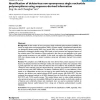Free Online Productivity Tools
i2Speak
i2Symbol
i2OCR
iTex2Img
iWeb2Print
iWeb2Shot
i2Type
iPdf2Split
iPdf2Merge
i2Bopomofo
i2Arabic
i2Style
i2Image
i2PDF
iLatex2Rtf
Sci2ools
BMCBI
2008
2008
Identification of deleterious non-synonymous single nucleotide polymorphisms using sequence-derived information
Background: As the number of non-synonymous single nucleotide polymorphisms (nsSNPs), also known as single amino acid polymorphisms (SAPs), increases rapidly, computational methods that can distinguish disease-causing SAPs from neutral SAPs are needed. Many methods have been developed to distinguish disease-causing SAPs based on both structural and sequence features of the mutation point. One limitation of these methods is that they are not applicable to the cases where protein structures are not available. In this study, we explore the feasibility of classifying SAPs into disease-causing and neutral mutations using only information derived from protein sequence. Results: We compiled a set of 686 features that were derived from protein sequence. For each feature, the distance between the wild-type residue and mutant-type residue was computed. Then a greedy approach was used to select the features that were useful for the classification of SAPs. 10 features were selected. Using the sel...
| Added | 08 Dec 2010 |
| Updated | 08 Dec 2010 |
| Type | Journal |
| Year | 2008 |
| Where | BMCBI |
| Authors | Jing Hu, Changhui Yan |
Comments (0)

